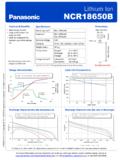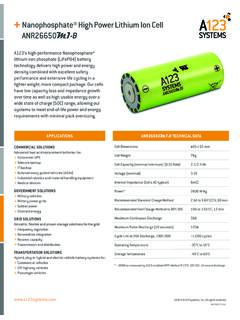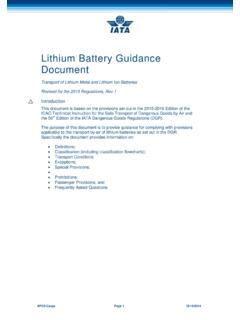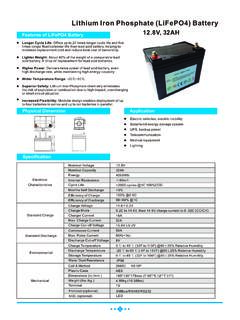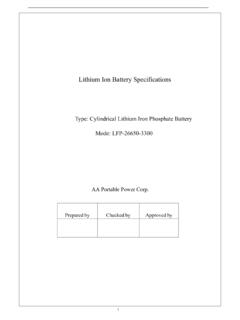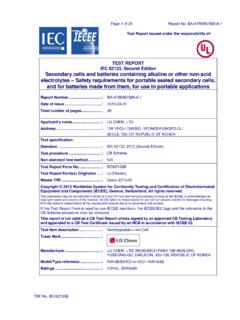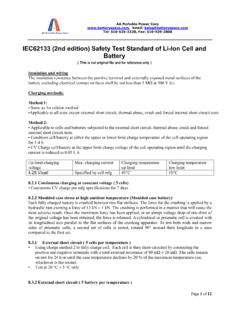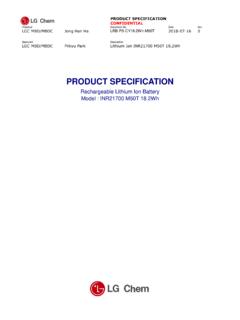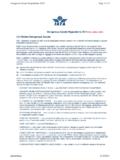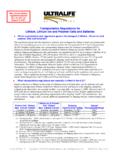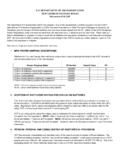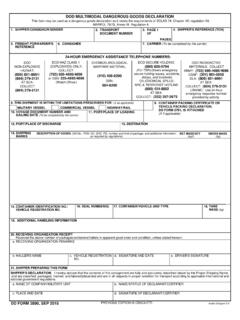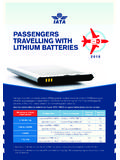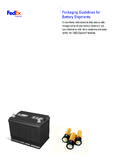Transcription of Recommendations on the TRANSPORT OF …
1 Recommendations on the TRANSPORT OF dangerous GOODS Manual of Tests and Criteria Fifth revised edition Amendment 1 UNITED NATIONS SECTION 38 Amend to read as follows: " Lithium metal and lithium ion batteries Purpose This section presents the procedures to be followed for the classification of lithium metal and lithium ion cells and batteries (see UN Nos. 3090, 3091, 3480 and 3481, and the applicable special provisions of Chapter of the Model Regulations). Scope All cell types shall be subjected to tests to and All non-rechargeable battery types, including those composed of previously tested cells, shall be subjected to tests to All rechargeable battery types, including those composed of previously tested cells, shall be subjected to tests to and In addition, rechargeable single cell batteries with overcharge protection shall be subjected to test A component cell that is not transported separately from the battery it is part of needs only to be tested according to tests and A component cell that is transported separately from the battery shall be tested as a cell.
2 Lithium metal and lithium ion cells and batteries shall be subjected to the tests, as required by special provisions 188 and 230 of Chapter of the Model Regulations prior to the TRANSPORT of a particular cell or battery type. Cells or batteries which differ from a tested type by: (a) For primary cells and batteries, a change of more than g or 20% by mass, whichever is greater, to the cathode, to the anode, or to the electrolyte; (b) For rechargeable cells and batteries, a change in nominal energy in Watt-hours of more than 20% or an increase in nominal voltage of more than 20%; or (c) A change that would lead to failure of any of the tests, shall be considered a new type and shall be subjected to the required tests.
3 NOTE: The type of change that might be considered to differ from a tested type, such that it might lead to failure of any of the test results, may include, but is not limited to: (a) A change in the material of the anode, the cathode, the separator or the electrolyte; (b) A change of protective devices, including hardware and software; (c) A change of safety design in cells or batteries, such as a venting valve; (d) A change in the number of component cells; and (e) A change in connecting mode of component cells. In the event that a cell or battery type does not meet one or more of the test requirements, steps shall be taken to correct the deficiency or deficiencies that caused the failure before such cell or battery type is retested. For the purposes of classification, the following definitions apply: Aggregate lithium content means the sum of the grams of lithium content contained by the cells comprising a battery.
4 - 43 - Battery means two or more cells which are electrically connected together and fitted with devices necessary for use, for example, case, terminals, marking and protective devices. A single cell battery is considered a "cell" and shall be tested according to the testing requirements for "cells" for the purposes of the Model Regulations and this Manual (see also the definition for "cell"). NOTE: Units that are commonly referred to as "battery packs", "modules" or "battery assemblies" having the primary function of providing a source of power to another piece of equipment are for the purposes of the Model Regulations and this Manual treated as batteries.
5 Button cell or battery means a round small cell or battery when the overall height is less than the diameter. Cell means a single encased electrochemical unit (one positive and one negative electrode) which exhibits a voltage differential across its two terminals. Under the Model Regulations and this Manual, to the extent the encased electrochemical unit meets the definition of "cell" herein, it is a "cell", not a "battery", regardless of whether the unit is termed a "battery" or a "single cell battery" outside of the Model Regulations and this Manual. Component cell means a cell contained in a battery. Cycle means one sequence of fully charging and fully discharging a rechargeable cell or battery. Disassembly means a vent or rupture where solid matter from any part of a cell or battery penetrates a wire mesh screen (annealed aluminium wire with a diameter of mm and grid density of 6 to 7 wires per cm) placed 25 cm away from the cell or battery.
6 Effluent means a liquid or gas released when a cell or battery vents or leaks. Fire means that flames are emitted from the test cell or battery. First cycle means the initial cycle following completion of all manufacturing processes. Fully charged means a rechargeable cell or battery which has been electrically charged to its design rated capacity. Fully discharged means either: a primary cell or battery which has been electrically discharged to remove 100% of its rated capacity; or a rechargeable cell or battery which has been electrically discharged to its endpoint voltage as specified by the manufacturer. Large battery means a lithium metal battery or lithium ion battery with a gross mass of more than 12 kg. Large cell means a cell with a gross mass of more than 500 g.
7 Leakage means the visible escape of electrolyte or other material from a cell or battery or the loss of material (except battery casing, handling devices or labels) from a cell or battery such that the loss of mass exceeds the values in Table Lithium content is applied to lithium metal and lithium alloy cells and batteries, and for a cell means the mass of lithium in the anode of a lithium metal or lithium alloy cell, which for a primary cell is measured when the cell is in an undischarged state and for a rechargeable cell is measured when the cell is fully charged. The lithium content of a battery equals the sum of the grams of lithium content contained in the component cells of the battery.
8 - 44 - Lithium ion cell or battery means a rechargeable electrochemical cell or battery in which the positive and negative electrodes are both intercalation compounds (intercalated lithium exists in an ionic or quasi-atomic form with the lattice of the electrode material) constructed with no metallic lithium in either electrode. A lithium polymer cell or battery that uses lithium ion chemistries, as described herein, is regulated as a lithium ion cell or battery. Mass loss means a loss of mass that exceeds the values in Table below. Table : Mass loss limit Mass M of cell or battery Mass loss limit M < 1 g l g M 75 g M > 75 g NOTE: In order to quantify the mass loss, the following procedure is provided: (M1 M2)Mass loss (%) = x 100M1 where M1 is the mass before the test and M2 is the mass after the test.
9 When mass loss does not exceed the values in Table , it shall be considered as "no mass loss". Nominal energy or Watt-hour rating, expressed in watt-hours, means the energy value of a cell or battery determined under specified conditions and declared by the manufacturer. The nominal energy is calculated by multiplying nominal voltage by rated capacity expressed in ampere-hours. Nominal voltage means the approximate value of the voltage used to designate or identify a cell or battery. Open circuit voltage means the voltage across the terminals of a cell or battery when no external current is flowing. Primary cell or battery means a cell or battery which is not designed to be electrically charged or recharged. Prismatic cell or battery means a cell or battery whose ends are similar, equal and parallel rectilinear figures, and whose sides are parallelograms.
10 Protective devices means devices such as fuses, diodes and current limiters which interrupt the current flow, block the current flow in one direction or limit the current flow in an electrical circuit. Rated capacity means the capacity, in ampere-hours or milliampere-hours, of a cell or battery as measured by subjecting it to a load, temperature and voltage cut-off point specified by the manufacturer. NOTE: The following IEC standards provide guidance and methodology for determining the rated capacity: (1) IEC 61960 (First Edition 2003-12) : Secondary cells and batteries containing alkaline or other non-acid electrolytes Secondary lithium cells and batteries for portable applications; (2) IEC 62133 (First Edition 2002-10): Secondary cells and batteries containing alkaline or other non-acid electrolytes Safety requirements for portable sealed secondary cells, and for batteries made from them, for use in portable applications; (3) IEC 62660-1 (First Edition 2011-01): Secondary lithium-ion cells for the propulsion of electric road vehicles Part 1: Performance testing.
